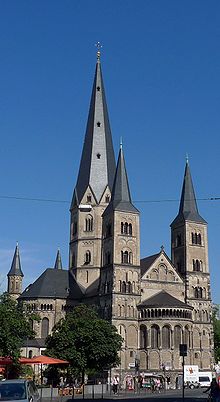Bonn Minster
 From Wikipedia the free encyclopedia
From Wikipedia the free encyclopedia
| Minster of St. Martin's | |
|---|---|
 Bonn Minster | |
| Religion | |
| Affiliation | Catholic |
| Ecclesiastical or organizational status | Papal basilica minor |
| Location | |
| Location | Bonn, Germany |
| Geographic coordinates | 50°44′00″N 7°05′59″E / 50.73333°N 7.09972°E |
| Architecture | |
| Type | minster |
| Style | Romanesque architecture |
| Specifications | |
| Direction of façade | East, Slightly Southeast |
| Height (max) | 81.4 meters |
| Dome(s) | None |
| Spire(s) | Five |
| Website | |
| www | |
Bonn Minster (German: Bonner Münster) is a Catholic church in Bonn. It is one of Germany's oldest churches, having been built between the 11th and 13th centuries. At one point the church served as the de facto cathedral for the Archbishopric of Cologne, because it is the major church of what was then the Archbishop-Elector's residence. It is now a minor basilica. It served as the inspiration for the Kaiser Wilhelm Memorial Church in Berlin, as Kaiser Wilhelm II had studied in Bonn.
History
[edit]The basilica was built on the site of the graves of two martyrs Cassius and Florentius, the patrons of Bonn. They are piously believed to have been Roman legionaries of the Theban Legion.[1] At some point during their march to Gaul, the legion refused to follow the emperor's orders either to kill the indigenous Christians or to worship Maximian as a god. As a result, a large number of legionaries were martyred in Agaunum, now named Saint Maurice-en-Valais after Saint Maurice. According to legend, Saints Cassius and Florentius, who were under the command of Saint Gereon, were beheaded for their religious beliefs at the present location of the Minster.
A memorial chapel was built in the early fourth century in what was a suburban cemetery about 1 km south of the Roman fortress. In the sixth century, a memorial building took its place. In the eighth century the Collegiate Church of SS. Cassius and Florentius" was built. The medieval town developed around the minster. A late Romanesque monastic church was constructed from 1140 to 1250. At one point the church served as the cathedral for the Archbishopric of Cologne.[2] The cathedral was the model for the Gedächtniskirche in Berlin. On Pentecost Sunday 1956, the church was elevated to the status of a minor basilica.
A fund raising initiative was launched in 2014 for necessary renovations to the 1,000-year-old building to address cracks in the vault, water damage, and an aging electric service, among other concerns.[3]
Architecture
[edit]The church has square towers decorated with Lombard bands;[2] a Romanesque feature, the minster also shows adaptation of some Gothic elements.[4] Writer T. Francis Bumpus said, "The most beautiful stone spire in Germany is that of the minster at Bonn."[5]
Interior
[edit]The Minster in Bonn housed one of the first organs in Germany, when in 1230 one was placed on the east wall in the north transept.[6]
Gallery
[edit]- Sculptures of the legendary Cassius and Florentius in front of the church
- Exterior of the church
- Transept and crossing tower
- Detail of the main entrance with the coat of arms of the Holy See
- Equestrian relief of St. Martin of Tours
See also
[edit]References
[edit]- ^ Christoph Keller (May 2006). "Legende auf dem Prüfstand". Archäologie in Deutschland. 5.
- ^ a b "Bonn Minster", CurateND
- ^ My Bonn Minster
- ^ Nussbaum, Norbert. German Gothic Church Architecture, Yale University Press, 2000, p. 29 ISBN 9780300083217
- ^ Bumpus, Thomas Francis. The Cathedrals and Churches of the Rhine and North Germany, Laurie, 1906, p. 108
- ^ "The Minster Organ celebrates its Golden Jubilee in 2011", Johannes Klais Orgelbau GmbH & Co.
External links
[edit] Media related to Bonn Minster at Wikimedia Commons
Media related to Bonn Minster at Wikimedia Commons- Ulrike Muessemeier (2004). "Die merowingerzeitlichen Funde aus der Stadt Bonn und ihrem Umland" (Dissertation). Bonn.
{{cite journal}}: Cite journal requires|journal=(help)




